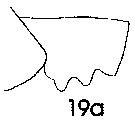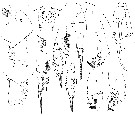|
|
 |
Fiche d'espèce de Copépode |
|
|
Calanoida ( Ordre ) |
|
|
|
Clausocalanoidea ( Superfamille ) |
|
|
|
Euchaetidae ( Famille ) |
|
|
|
Paraeuchaeta ( Genre ) |
|
|
| |
Paraeuchaeta incisa (Sars, 1905) (F,M) | |
| | | | | | | Syn.: | Euchaeta incisa Sars, 1905 b (p.17, Rem.F); Vervoort, 1957 (p.77); Park, 1975 c (p.17, Descr.M, figs.F,M, Rem.); Deevey & Brooks, 1977 (p.256, tab.2, Station "S"); Mauchline, 1992 a (p.2); 1999 (n°182, p.9, figs.F,M);
Pareuchaeta incisa : Sars, 1925 (p.117, figs.F); Vives, 1982 (p.291); Lozano Soldevilla & al., 1988 (p.58) | | | | Ref.: | | | Sewell, 1948 (p.348, 501, 566, 569); Roe, 1972 (p.277, tabl.1, tabl.2); Bradford & al., 1983 (p.23); Park, 1994 (p.319); 1995 (p.79, Rem.F, M, figs. F,M) ; Vives & Shmeleva, 2007 (p.672, figs.F,M, Rem.) |  issued from : T. Park in Bull. Scripps Inst. Oceanogr. Univ. California, San Diego, 1995, 29. [p.186, Fig.76]. Female: a, forehead (left side); b, urosome (left); c, d, genital somite (left, right, respectively); e, A2; f, Mx1 (first inner lobe omitted), posterior; g, exopod of P1 (anterior); exopod of P2 (anterior). Nota: Cephalosomal appendages similar to those of P. norvegica except that seta on 2nd exopodal segment of A2 much developed. Outermost seta on basis of Mx1 also well developed. In P1 exopod, outer spine of 1st segment very small; that of 2nd segment short of reaching base of following outer spine. In P2 exopod, outer spine of 2nd segment extending beyond distal end of following outer spine and about as long as 2nd outer spine of 3rd segment; incision separating 2nd marginal lobe of 3rd segment relatively deep. Male: i, forehead (left); j, last pedigerous and genital somites (left); k, exopod of P1 (anterior); l, exopod of P2 (anterior); m, exopod of left 5th leg (medial); n, distal exopodal segments of left 5th leg (medial, tilted counterclockwise); o, idem (lateral, tilted clockwise); p, idem (anterior, tilted counterclockwise).
|
 Issued from : G.O. Sars in Résult. Camp. Scient. Prince Albert I, 69, pls.1-127 (1924). [Pl.XXXII, figs.7-11]. As Pareuchaeta incisa. Female: 7, habitus (dorsal); 8, idem (lateral left side); 9, forehead (lateral); 10, genital somite (lateral left side); 11, genital complex (ventral).
|
 issued from : J. Mauchline in ICES Ident. Leafl. Plankton, 1999, N°182. [p.3, Fig.2: 19a]. As Euchaeta incisa. Female (Northeast Atlantic): 19a, genital double-somite (left side).
|
 issued from : J. Mauchline in ICES Ident. Leafl. Plankton, 1999, N°182. [p.4, Fig.3: 19b]. As Euchaeta incisa. Male (Northeast Atlantic): 19b, terminal two segments, exopodal segments of left P5.
|
 issued from : T. Park in Smiths. Contr. Zool., 1975, 196. [p.18, Fig.15]. As Euchaeta incisa. Female (G. of Mexico): a, forehead (lateral); b-c, genital segment (left side and right side, respectively); d, same (ventral); e, outer lobe of Mx1; f, P1 (anterior); g, P2 (anterior). Male: h, forehead (lateral); i, exopod of P1 (anterior); j, exopod of P2 (anterior); k, P5 (anterior); l, exopod of left P5 (anterior); m, same (lateral); n, same (medial). The male is described for the first time. Nota: Females and males were found mainly in tows down to depths over 1000 m.
|
 Paraeuchaeta incisa Paraeuchaeta incisa Female: 1 - See key to species Groups and independent species of Paraeuchaeta (p.30). 2 - Laterally, genital field facing ventrad, with large tubercular outgrowth behind genital orifice (Fig.76-c). 3 - Genital somite without transverse ridge on ventral side anterior to genital prominence (Fig.76-c). 4 - Laterally, genital flange conical and tail (Fig.76-c).
| | | | | Ref. compl.: | | | Grice, 1963 a (p.495); Suarez-Morales & Gasca, 1998 a (p.109); Lapernat, 2000 (tabl.3, 4) | | | | NZ: | 3 | | |
|
Carte de distribution de Paraeuchaeta incisa par zones géographiques
|
| | | | Loc: | | | off NW Cape Verde Is., off Morocco-Mauritania, Canary Is., off N Madeira, off SW Azores, E Sargasso Sea, Caribbean Sea, G. of Mexico, off Bermuda: Station "S" (32°10'N, 64°30'W), off N Cape Hatteras, off Rockall Is., [[ Philippines, China Seas, off California, Hawaii, off Peru, off W Juan Fernandez Is. (references Pacific only in C. B. Wilson, 1942 a, p.201; 1950, p.283; Fagetti, 1962, p.22); non maintained by Park (1995 )]]. | | | | N: | 11 | | | | Lg.: | | | (1) F: 5,6; (3) F: 5,8-5,5; M: 5,3; (19) F: 5,75-5,41; M: 5,75-4,83; (199) F: 5,92; {F: 5,41-5,92; M: 4,83-5,75} | | | | Rem.: | méso-bathypélagique.
Les localisations dans le Pacifique sont à confirmer.
Voir aussi les remarques en anglais | | | Dernière mise à jour : 27/01/2015 | |
|
|
 Toute utilisation de ce site pour une publication sera mentionnée avec la référence suivante : Toute utilisation de ce site pour une publication sera mentionnée avec la référence suivante :
Razouls C., Desreumaux N., Kouwenberg J. et de Bovée F., 2005-2025. - Biodiversité des Copépodes planctoniques marins (morphologie, répartition géographique et données biologiques). Sorbonne Université, CNRS. Disponible sur http://copepodes.obs-banyuls.fr [Accédé le 27 août 2025] © copyright 2005-2025 Sorbonne Université, CNRS
|
|
 |
 |








